Los Angeles in the 1960s was a city of contrasts, where the sunny and glamorous image of Hollywood coexisted with the social and political turmoil of the civil rights movement, the Vietnam War, and the counterculture.
The decade saw the emergence of diverse and influential musical styles, from the surf rock of the Beach Boys to the folk rock of the Byrds and the psychedelic rock of the Doors.
The city also became a hub for the film industry, producing classics such as The Graduate, Easy Rider, and Rosemary’s Baby.
The 1960s also witnessed the rise and fall of various subcultures and movements in Los Angeles, such as the Chicano movement, the Black Panthers, the hippies, and the Manson Family.
The city experienced some of the most violent and tragic events of the era, such as the Watts riots, the assassination of Robert F. Kennedy, and the Tate-LaBianca murders.
Despite the challenges and conflicts, Los Angeles also fostered a spirit of creativity, innovation, and activism that shaped its cultural identity and legacy
Table of Contents
Los Angeles Greyhound Bus Terminal (1969)

Imagine traveling back in time to 1969 and walking into the Los Angeles Greyhound bus station.
The waiting area was filled with fancy-looking chairs that were shaped like something from outer space.
People dressed up nicely in suits and dresses to travel, and they sat in these comfy chairs while waiting for their buses.
The best part about these chairs was that each one had its own little TV attached to it. So, if you had some spare change, you could put coins into the TV and watch your favorite shows right from your seat.
It was like having your own personal theater while you waited. Today, we have smartphones and tablets to keep us busy, but back then, having a TV in your chair was a really big deal.
The Los Angeles Greyhound bus station in 1969 was a place where people could relax and enjoy themselves before starting their trips.
Dodger Stadium (1969)

The construction of Dodger Stadium is a complex and fascinating story that highlights the tensions between urban development, community interests, and political maneuverings.
In the early 1950s, the city of Los Angeles had grand plans to build a massive public housing project in the Chavez Ravine neighborhood, a vibrant community located in the hills just a few miles from downtown.
The residents of Chavez Ravine, many of whom were Mexican-American families, had built their homes and lives in this close-knit community for generations.
However, the city’s vision for the area ultimately led to their displacement, as they were forced to sell their homes to make way for the new housing development. But the story took an unexpected turn when the public housing plan fell through due to political opposition.
Instead, the city entered negotiations with the owner of the Brooklyn Dodgers, Walter O’Malley, to bring the team to Los Angeles.
The Chavez Ravine site was then repurposed as the location for a brand-new, state-of-the-art baseball stadium – Dodger Stadium.
This decision, made without the input or consent of the displaced Chavez Ravine residents, was seen by many as a betrayal and a devastating loss of their beloved community.
The construction of Dodger Stadium, then, became a symbol of the power of urban renewal and the often-overlooked human cost of such ambitious development projects.
Len Dawson smokes at the first Super Bowl halftime (1967)
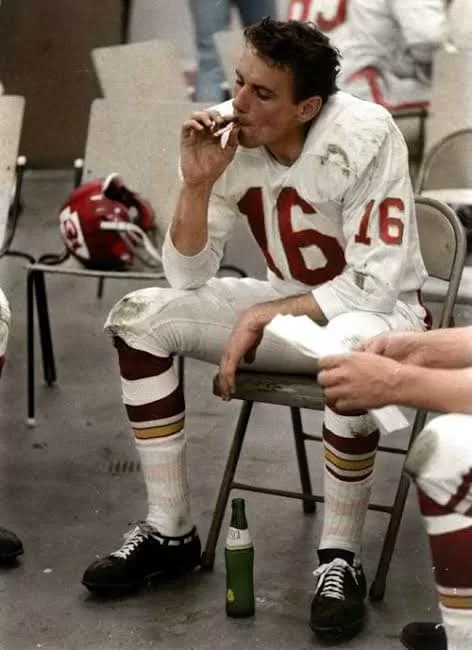
On January 15, 1967, the very first Super Bowl was played at the Los Angeles Memorial Coliseum.
The Green Bay Packers were leading the Kansas City Chiefs 14-10 at halftime.
During the break, Life magazine photographer Bill Ray captured an incredible image.
He snapped a photo of Chiefs quarterback Len Dawson sitting on a folding chair, smoking a cigarette.
Dawson was still in his dirty uniform with the number 16 on it.
The famous black and white picture (colorized here) shows Dawson taking a drag, with a bottle of Fresca soda at his feet. In those days, it was very common for football players and coaches to smoke cigarettes, even during games.
Over half the Chiefs players smoked at halftime back then, according to teammate Fred Arbanas.
While it seems crazy now, smoking was accepted and hardly seen as unhealthy in 1967.
The photo of the Chiefs’ legend Dawson puffing away has become an iconic image.
It captures how different professional football was over 50 years ago compared to today’s multi-billion dollar health-conscious league.
Dawson’s halftime smoke break will always symbolize the historic first Super Bowl.
Third Street Promenade. Santa Monica (1965)

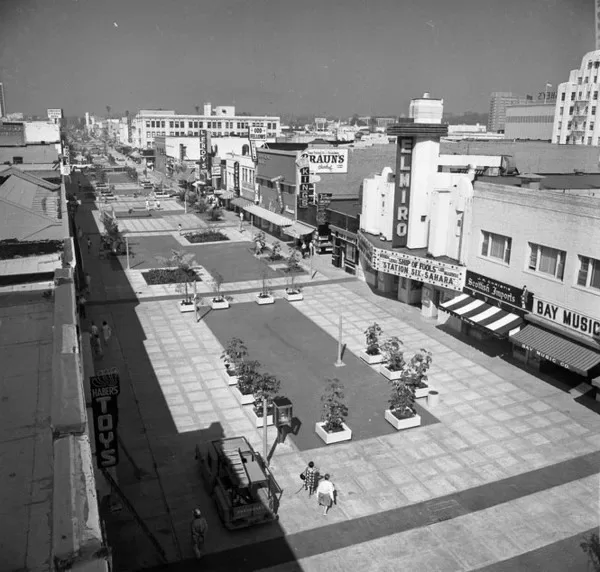
In 1959, Ernest Gulsrud, president of the Santa Monica Chamber of Commerce, proposed converting three blocks of Third Street into a pedestrian mall, inspired by Kalamazoo’s success.
Third Street struggled against newer shopping centers with ample parking.
Despite opposition from Ralphs supermarket, the city approved the plan in 1965.
On April 22, construction began with a three-minute car horn ceremony.
Charles Luckman’s $700,000 design replaced the roadway with landscaping like planters and reflecting pools.
The $1.5 million Santa Monica Mall opened November 8, 1965.
While initially popular, the Mall failed to revive the area long-term.
New parking garages hurt surrounding street life, and Santa Monica Place mall’s 1980 opening led to vacant storefronts.
By the mid-80s, the Mall floundered.
The city invested $10 million in 1987 for ROMA Design Group’s renovation, reopening September 16, 1989 as the Third Street Promenade with a 20-foot roadway amid 30-foot sidewalks.
Though vehicles were initially allowed off-peak, the Promenade’s popularity led to permanent bollards banning cars.
Mouseketeer Icon Annette Funicello’s Fabulous Purple 1957 Thunderbird
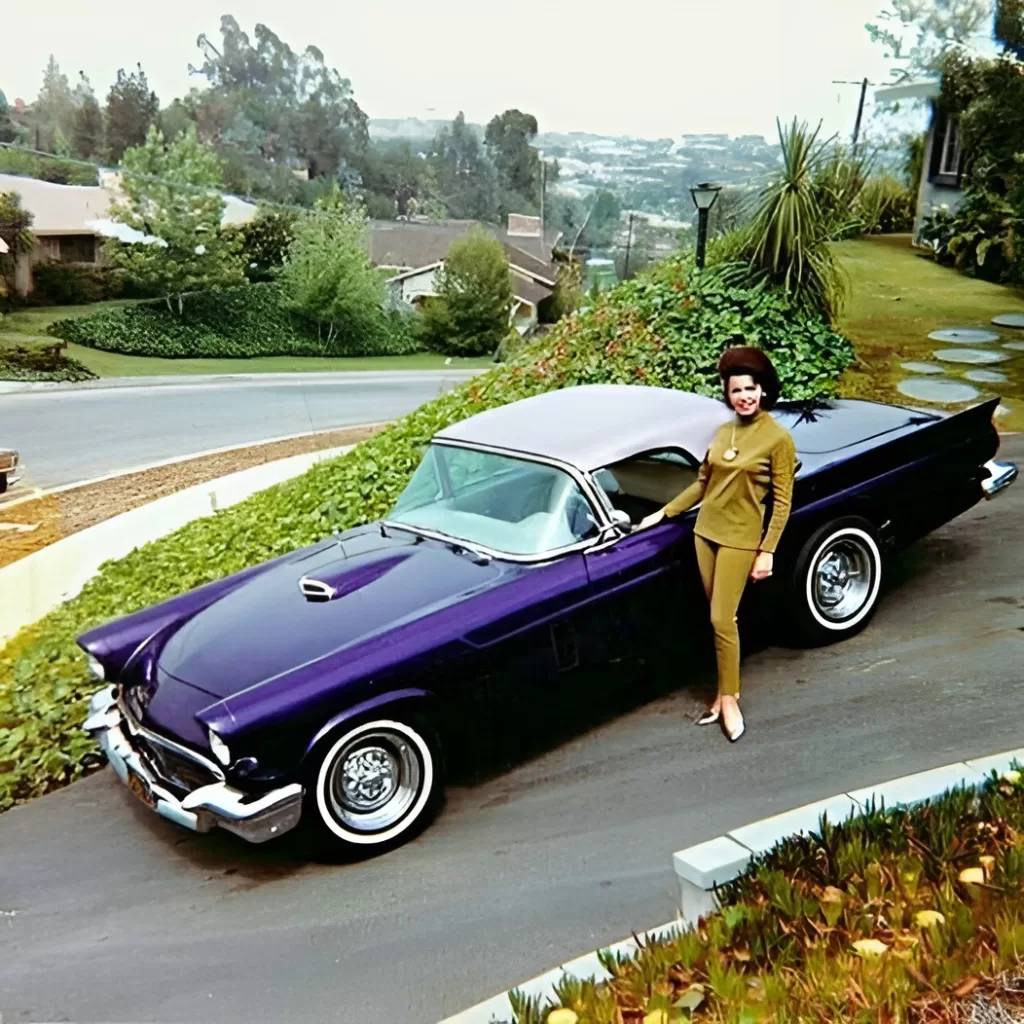
In 1963, former Mouseketeer and beloved actress Annette Funicello was photographed with her custom purple 1957 Ford Thunderbird on Adlon Road in Encino, California.
The vibrant purple paint job on the classic T-Bird made it a real head-turner. The car also featured stylish chrome reverse wheels, which were an upscale optional extra in those days.
The photo captures the smiling 21-year-old Funicello posing proudly next to her unique ride.
She had risen to fame as a cherubic child star on The Mickey Mouse Club in the 1950s before transitioning to a successful career as a television actress and singer.
The purple Thunderbird was fitting for the effervescent young celebrity known for roles in the popular Beach Party movies co-starring Frankie Avalon.
Funicello’s car reflected her fun-loving spirit and stood out from the typical cars of the era.
The Theme Building LAX (1965)

The Theme Building at Los Angeles International Airport (LAX) is a renowned architectural example of the Space Age design style.
The initial design was created by James Langenheim, of Pereira & Luckman.
The design was then brought to fruition by a team of architects and engineers headed by William Pereira and Charles Luckman, that also included Paul Williams and Welton Becket.
he distinctive white building, which resembles a flying saucer that has landed on its four legs, is an example of the Mid-century modern design movement later to become known as “Googie”.
The original design for the airport created by Pereira & Luckman in 1959 had all the terminal buildings and parking structures connected to a huge glass dome, which would serve as a central hub for traffic circulation.
However, the plan was eventually scaled down considerably, and the terminals were constructed elsewhere on the property.
The Theme Building was subsequently built to mark the spot intended for the dome structure, as a reminder of the original plan.
The structure was dedicated on June 25, 1961, by Vice President Lyndon B. Johnson.
The Los Angeles City Council designated the building, which lies within the Westchester neighborhood of the city of Los Angeles, a historic-cultural monument (no. 570) in 1993.
JFK “The New Frontier” Speech at the LA Coliseum

It was a historic moment for John F. Kennedy and the Democratic Party, as he accepted the nomination for president at the Los Angeles Coliseum on July 15, 1960.
He delivered a powerful speech that outlined his vision of “the New Frontier”, a set of challenges and opportunities for the American people in the 20th century.
He spoke of the need for courage, innovation, and leadership in the face of domestic and international issues, such as civil rights, poverty, education, science, and the Cold War.
He also appealed to the ideals of democracy, freedom, and human dignity, and urged his fellow citizens to join him in a quest for progress and justice.
The speech was met with enthusiastic applause and cheers from the crowd of eighty thousand people, who filled the stadium with banners, signs, and balloons.
Many of them had waited for hours in the hot sun to hear Kennedy speak, and they were not disappointed.
The speech was also broadcast live on television and radio, reaching millions of viewers and listeners across the nation and the world.
It was widely praised by the media and the public, and it helped to boost Kennedy’s popularity and momentum in the presidential campaign.
The speech later became known as “The New Frontier” speech, and it is regarded as one of the most influential and memorable speeches in American political history
101 Heading Toward Bill Keene Memorial Interchange
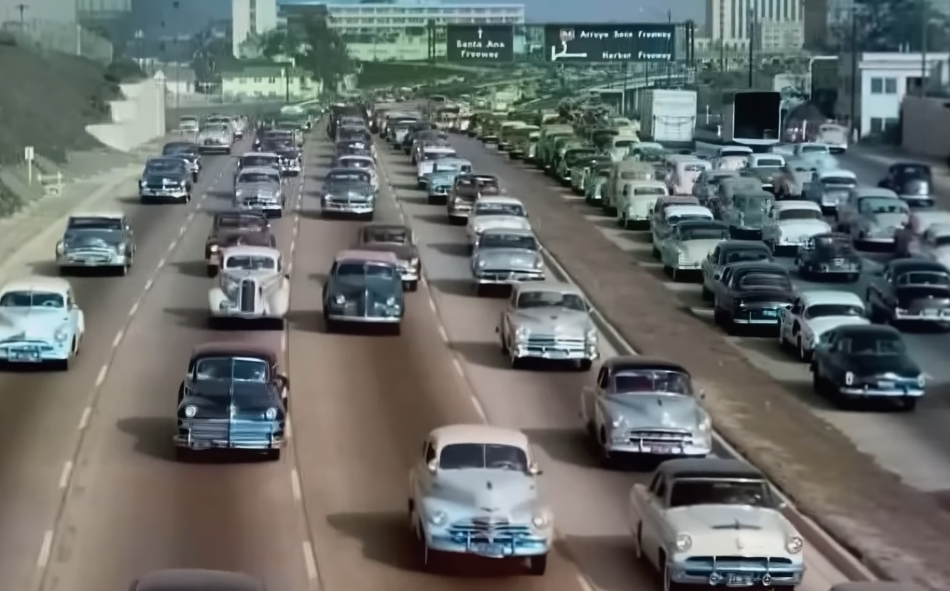


The first stack interchange in the world, completed in 1949 and fully opened in 1953 at the northern edge of downtown Los Angeles, California.
It connects U.S. Route 101 (Hollywood Freeway and Santa Ana Freeway) to State Route 110 (Harbor Freeway and Arroyo Seco Parkway).
The interchange was designed by a team of engineers and built by the James I. Barnes Construction Company. It has four levels of viaducts and flyover ramps that allow free-flowing movement in all directions. The Arroyo Seco Parkway, also known as the Pasadena Freeway, is one of the oldest freeways built in the United States.
The parkway connects Los Angeles with Pasadena alongside the Arroyo Seco seasonal river.
It is notable not only for being an early freeway, mostly opened in 1940, but for representing the transitional phase between early parkways and later freeways.
It conformed to modern standards when it was built, but is now regarded as a narrow, outdated roadway.
The parkway is part of State Route 110, which begins at the Four Level Interchange and ends at Glenarm Street in Pasadena.
The parkway is designated a State Scenic Highway, National Historic Civil Engineering Landmark, and National Scenic Byway. It was listed in the National Register of Historic Places in 2011.
Super Bowl I, January 15, 1967 LA Coliseum

On January 15, 1967, the first Super Bowl, now a legendary event in American sports history, took place.
The Green Bay Packers and the Kansas City Chiefs faced off on a sunny afternoon at the Los Angeles Coliseum.
The weather was perfect for football, with the temperature hovering around a comfortable 72 degrees. The Packers emerged victorious, defeating the Chiefs with a decisive score of 35-10.
Despite the significance of the event, ticket prices were surprisingly affordable at just $12.
However, the inaugural Super Bowl did not attract the sell-out crowds we see today, marking a humble beginning for what would become one of the most-watched events in American television history.
Walt Disney signing autographs on Main Street at Disneyland (1963)
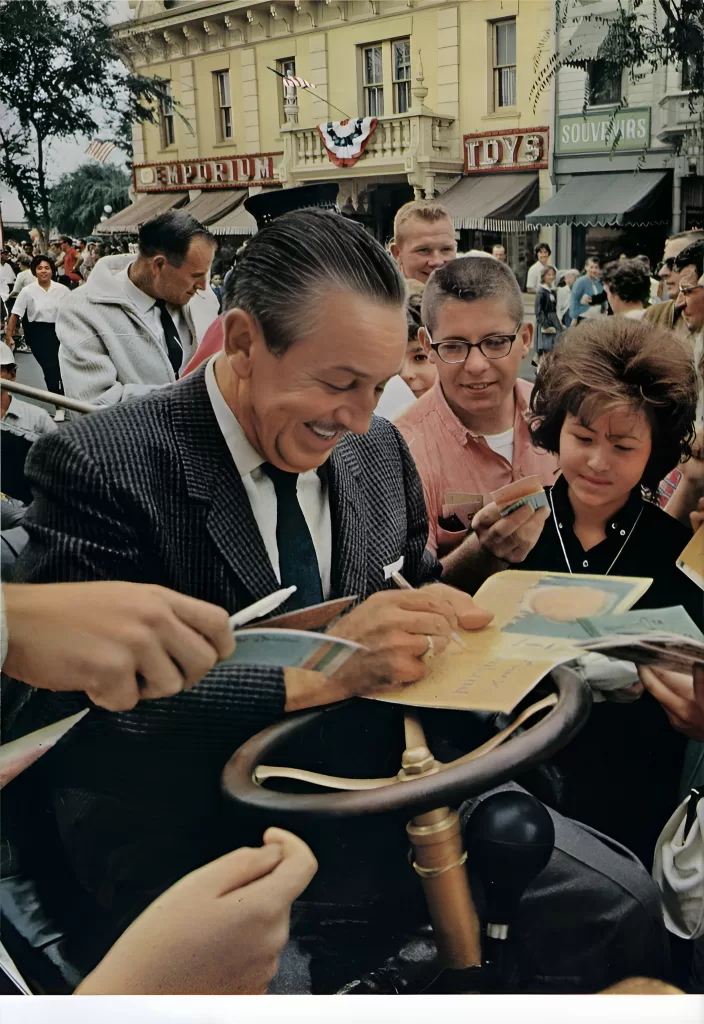
This rare picture was part of a special photographic report for the National Geographic magazine.
In the report, it talked about Walt Disney’s dream of creating a family amusement park becoming a reality in 1955 with the opening of Disneyland in Anaheim, California.
The $17 million park was built on 244 acres of former orange groves, surrounded by a high berm to shut out the outside world.
Disneyland was divided into different themed lands like Main Street U.S.A., recreating Walt’s childhood memories, and exotic Adventureland with its jungle river cruise.
Walt spared no detail, using cutting-edge technology like the multi-plane camera system to create astonishing three-dimensional effects in the attractions. From day one, Disneyland was an immense success, with Walt continually adding new lands and innovations.
By 1963, additions like the Matterhorn mountain bobsled coaster and the Monorail system had been unveiled to excited guests.
Walt’s creation combined nostalgia, imagination, and technological marvels into a “magic kingdom” unlike anything ever seen before.
As the National Geographic described it, people of all ages were captivated by Walt’s ability to bring fantasies and faraway places to life through his remarkable vision and dedication to storytelling.